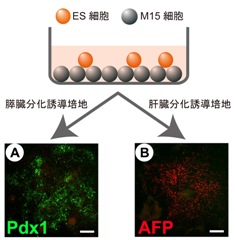
Shiraki, N., Umeda, K., Sakashita, N., Takeya, M., Kume K. and Kume S. Differentiation of mouse and human ES cells into hepatic lineages. Genes Cells, Vol.13 issue7, 2008. Published article online: 30-May-2008 doi: 10.1111/j.1365-2443.2008.01201.x
We recently reported a novel method to induce embryonic stem (ES) cells differentiate into an endodermal fate, especially pancreatic, using a supporting cell line. Here we describe the modified culture condition with the addition and withdrawal of secreted growth factors could induce ES cells to selectively differentiate into a hepatic fate efficiently. The signaling of BMP and FGF that have been implicated in hepatic differentiation during normal embryonic development are shown to play pivotal roles in generating hepatic cells from the definitive endoderm derived from ES cells. Moreover, the expression of AFP, Albumin or a biliary molecular marker appeared sequentially thus suggested the differentiation of ES cells recapitulated normal developmental processes of liver. The ES cell-derived differentiated cells showed evidence of glycogen storage, secreted Albumin, exhibited drug metabolism activities and expressed a set of cytochrome or drug conjugate enzymes, drug transporters specifically expressed in mature hepatocytes. With the same procedure, human ES cells also gave rise to cells with mature hepatocytes’ characteristics. In conclusion, this novel procedure for hepatic differentiation will be useful for elucidation of molecular mechanisms of hepatic fate decision at gut regionalization, and could represent an attractive approach for a surrogate cell source for pharmaceutical studies such as toxicology.

Figure: M15, a mesoderm-derived cell line, can direct the differentiation of ES cells into hepatic fate, in addition to a pancreatic fate previously described (Shiraki et al., 2008).
ES cells are grown on M15, under conditions for pancreatic differentiation (left panel) or for hepatic differentiation (right panel). (A) Under pancreatic differentiation condition, ES cells differentiate into Pdx1 /GFP-expressing cells (green). (B) Under hepatic differentiation, ES cells differentiate into α -fetoprotein-expressing cells (red).